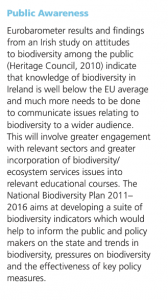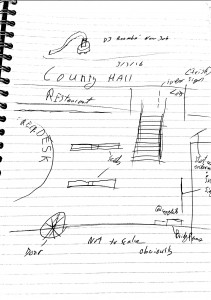Pretty simple everyday things people can take to help the pollinator clan.
Tips from the natural wildlife federation.
Brús Pearse & Michael O' Farrell
Pretty simple everyday things people can take to help the pollinator clan.
Tips from the natural wildlife federation.
Here is a page that suggests what companies can do to promote biodiversity in the workplace. The employers can become more green planting trees, having more green spaces and wildflower around the building.
It is interesting that they have some ideas how to engage employees to encourage to promote biodiversity. All the suggestions offer information to external resources. (World Wildlife Day, ESB Tree Week, Greennews.ie events).
There is a demand to create a SMART object that would create awareness within a business or organisation to improve biodiversity whilst engaging the staff.
This was a public survey done to allow feedback on the draft pollinator plan. 37 responses were received. I think this gives a good indication of the public perception of the implementation of the proposed idea and contains some information that might be relevant to us. Some points that might be relevant from the survey.
Under question 1, 100% of people were supportive of developing an All-Ireland Pollinator Plan. Under question 2 the Plan scored an average of 3 out of 5 in terms of how confident the respondents were, that over the next five years, this Plan will build a solid foundation to bring about a landscape where pollinators can flourish (1= not confident, 5=very confident).
The emphasis has been changed to better stress the preference for maintaining natural nesting habitat and forage sources within the landscape.
Hedgerows. Many respondents pointed out the importance of good quality hedgerows as a pollinator habitat within the farmed landscape. This is recognised and emphasised in the revised Plan.
Pesticides. Some respondents called for a full ban on the use of pesticides. The Pollinator Plan supports the National Action Plan for the Sustainable Use of Pesticides (2013).
Local seed. Where members of the public want to plant wildflowers in their garden this should be local provenance if possible. It is suggested that training courses in the collection, storage and use of locally collected seed be explored. This has been added as an action.
Better education on pollinators: some respondents raised the issue that some new entrants into beekeeping have taken it up because of a perceived benefit to local pollinator populations. Given the skill and expertise required for healthy beekeeping, they suggested that education programmes be run to show them that they could also benefit local pollinator populations by planting choices in their gardens, reduced mowing regimes on lawns etc.
Centralised education: an early alert system in the case of introduction of exotic diseases and will also help regulate bee movements around the country.
Baseline studies and monitoring: Widespread participation in the Bumblebee Monitoring Scheme should be encouraged and supported by training and resources.
One issue that seems to be repeated on every question is that there wasn’t enough engagement with other stakeholders. This points at a lack of communication between the business and organizations that are getting involved and the general public. Something we could also consider.
A study done in 2010 shows that Irelands knowledge on bio-diversity was well below the EU average. I was interested to find out if much had changed.

The national biodiversity indicators website had recent data on this area. While, public perception seems to be very positive in the feedback on the perception of the matter, media articles and Google searches on the area seem to be telling a different matter.
Maybe this should be something we should consider for the project. How can we increase public perception on the issues involved with the declining bee population and relate that to biodiversity issues.
Survey done by Eurobarometer. 1000 participants.
Google searches for biodiversity related terms.
Media articles related to biodiversity.
Website that looks at the Lee catchment area and out the flood management strategy they have for the area. The Lee Fields FRS Constraints Study gives detailed on past and current studies done in the area. Here are the list of native and non native species that are familiar to the Lee Fields area but who’s habitat are in danger.
Smooth Newt (Lissotriton vulgaris) and Common Frog (Rana temporaria)
One scarce parasitic woodland plant Ivy Broomrape (Orobanche hederae) which grows parasitically on Ivy (Hedera helix) is known from the Distillery Fields area
Many of the stone walls in Cork City support a diverse array of species including two listed under the Flora (Protection) Order, 1999, i.e. Roundleaved Cranesbill and Little Robin. These are listed as nationally ‘Vulnerable’ in the Irish Red Data Book
Roundleaved Cranesbill is found in very few sites in Ireland, one of which is waste ground areas around the city, where it has been recorded in greater numbers than at any of its other sites in Dublin and Wexford (Cork City Council, 2009).
According to (Cork City Council, 2009) the River Lee running west from the City to the Lee Fields is an excellent area for bats. Bats species recorded present include Common Pipistrelle, Soprano Pipistrelle, Daubenton’s Bat, Leisler Bat and Brown-long eared Bat. Natteries and Whiskered Bat have also been recorded in the environs the City
The Annex I bird species Kingfisher (Alcedo atthis) is known to occur on the River Lee along the Irish Dipper (Cinclus hibernicus). The River Lee supports a number of bird species of Special Conservation Interest listed for the coastal marine habitats of Cork Harbour SPA e.g Cormorant (Phalacrocorax carbo) and Grey Heron (Ardea cinerea)
European Eel (Anguilla anguilla), Salmon (Salmo salar) and Brown trout (Salmo trutta) were recorded. Sea Lamprey have also been recorded downstream of Lee Waterworks Weir. It is not known if these species can move upstream above the weir.
A recent survey by IWT (2012) undertaken between 2011 and 2012 to evaluate the Otter population in the inner city and the adjacent suburban areas identified a minimum population of 11 No.
O Mahony (2009) also describes an area of swampy scrub wood at the western boundary of the Lee Fields on the northern banks as being of ecological interest and refers to a series of small ponds in the eastern extremity of the Lee Fields containing Tubular Water Dropwort (Oenanthe fistulosa).
The Study Area was visited on the 18th June 2013 – non native species
Japanese Knotweed (Fallopia japonica) and other members of the knotweed family
o Giant Hogweed (Heracleum mantegazzianum).
o Himalayan Balsam (Impatiens glandulifera)
o Travellers Joy (Clematis vitalba)
o Snowberry (Symphoricarpos alba)
o Himalayan Honeysuckle (Leycesteria formosa)
o Winter Heliotrope (Petasites fragrans)
o Ground Elder (Aegopodium podagraria)
o Montbretia (Crocosmia x crocosmiiflora)
The following aquatic non-native invasive species is known from the River Lee and Carrigadrohid reservoir:
o Nutall’s Pondweed (Elodea nuttallii)
List of Birds in Danger:
A short documentary on how Oisín Kelly’s sculpture ended up in Cork. It was originally meant for Liberty Hall in Dublin.
“Unfortunately, Irish pollinators are in decline, with one third of our 98 bee species threatened with extinction,” said Dr Úna FitzPatrick from the National Biodiversity Data Centre. The full document can be found here and there is also a version for children found here.
The pollinator plan is a strategy to be put in place as a means of education to drive change in areas that will increase nesting areas and food that the landscape provides for bees. It is also about creating awareness about pollinators and how they can be protected by allowing wild flowers in fields to protect natural habitats.
It is n0t just about protecting bees as this pollinator service is the core service behind a crop industry that is worth an estimated €53 million to the Irish economy.
It is a shared plan of action. Some of the organisations involved are the Department of Agriculture, Food & the Marine, Teagasc, Bord Bía, Heritage Council, Fáilte Ireland, An Taisce Green Schools, Federation of Irish Beekeepers’ Associations, Iarnród Éireann,National Trust, RSPB, Tidy Towns and Waterways Ireland.
It is worth noting the 5 key points of the policy
1 Making Ireland pollinator friendly
2 Raising awareness of pollinators and how to protect them
3 Managed pollinators – supporting beekeepers and growers
4 Expanding our knowledge on pollinators and pollination service
5 Collecting evidence to track change and measure success
I went down to County Hall to carry out research about the space.
I went down to the space and took note of the area. I mapped out the area so I knew the space.

I observed the people who used the space and put them into 3 categories:



Visualising Mill Road + Fair Numbers
Here is a project I found that took the novel approach of using data gathered from public surveys to create public data visualizations. Their aim was to increase communication between two communities separated by a bridge. The fair numbers project was less successful in achieving this compared to the Mill Road project.
Mill road used local businesses to help gather the data. They have a broader area to work with to gather the data. Broadening our catchment area might be of benefit to us to help us speed up the data research. The North Main Street would be a perfect area for this.